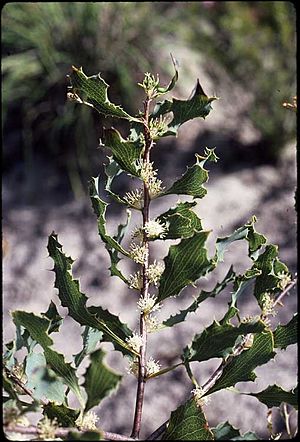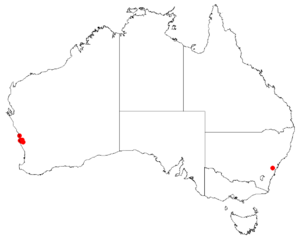Pink-flowered hakea facts for kids
Quick facts for kids Pink-flowered hakea |
|
|---|---|
 |
|
| Hakea neurophylla in Kings Park | |
| Conservation status | |
| Scientific classification | |
| Genus: |
Hakea
|
| Species: |
neurophylla
|
 |
|
| Where the pink-flowered hakea grows (data from AVH) | |
The pink-flowered hakea, officially known as Hakea neurophylla, is a special type of shrub. It's part of the Hakea plant family and grows naturally in a small area near Dandaragan in the Wheatbelt region of Western Australia.
Contents
What Does It Look Like?
This plant is a straight-growing shrub that usually reaches a height of 0.3 to 2 metres (about 1 to 6.5 feet). It does not sprout new shoots from its base after a fire.
Flowers
From July to August, the pink-flowered hakea produces many lovely, sweet-smelling flowers. These blooms grow in clusters along the branches, right where the leaves meet the stem. They can be white or a pale pink-red color. Each cluster has about 12 to 18 scented flowers.
Leaves and Fruit
The leaves of this hakea are a blue-grey color. They are shaped like an oval, wider at the top, and sometimes have wavy edges. They are usually 5 to 11 centimetres (about 2 to 4.3 inches) long and 16 to 43 millimetres (about 0.6 to 1.7 inches) wide. The leaves are narrow at the base and have three clear lines, or veins, running along them. These veins end in a rounded tip.
After flowering, the plant produces large, dark brownish-black fruits. These fruits are shaped like an egg, but a bit slanted. They are about 3 to 4 centimetres (about 1.2 to 1.6 inches) long and 1.5 to 1.9 centimetres (about 0.6 to 0.7 inches) wide. Each fruit has a small, unclear beak-like tip and a ridge along its back.
How It Got Its Name
The scientific name Hakea neurophylla was first officially described by a scientist named Carl Meisner in 1855.
The name "neurophylla" comes from two ancient Greek words:
- neuron, which means "nerve"
- phyllon, which means "leaf"
This name was chosen because the plant's leaves have very noticeable veins, which look a bit like nerves.
Where It Lives
The pink-flowered hakea is a rare plant. It only grows in a specific area of Western Australia, around the Mt Lesueur and Eneabba regions, which are north of Perth.
It prefers to grow in heathland areas, which are open spaces with low-growing shrubs. You'll usually find it in sandy soil that sits over a type of rock called laterite, often on the tops of ridges.
Protecting This Plant
The Western Australian Government's Department of Parks and Wildlife has given Hakea neurophylla a special conservation status. It is classified as "Priority Four - Rare." This means the plant is rare, but it's not immediately threatened. However, it still needs to be monitored and protected to make sure its numbers stay healthy in the wild.


